Discover 11 hidden attractions, cool sights, and unusual things to do in Hastings (United States). Don't miss out on these must-see attractions: Hastings City Hall, Hastings Bridge, and LeDuc Historic Estate. Also, be sure to include Ramsey Mill and Old Mill Park in your itinerary.
Below, you can find the list of the most amazing places you should visit in Hastings (Minnesota).
Table of Contents
Hastings City Hall
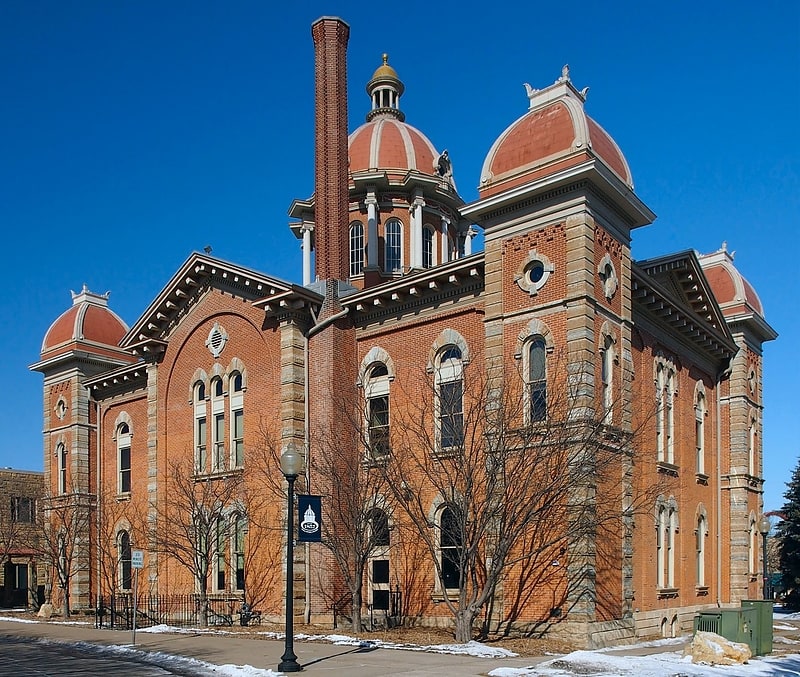
Building in Hastings, Minnesota. Hastings City Hall, formerly the Dakota County Courthouse, is a historic government building in Hastings, Minnesota, United States, completed in 1871. It was the original courthouse for Dakota County and now serves as city hall. It was designed by A.M. Radcliff, one of Minnesota's first architects, in an Italian Villa style. Although an addition built in 1955 in an entirely different style damaged the building's integrity, the building remains a prominent structure in downtown Hastings. The courthouse served as the seat of Dakota County government from 1871 until September 1974, when the county commissioners held their last meeting in the building. It became the Hastings City Hall in 1993.[1]
Address: 216 E 4th St, Hastings
Hastings Bridge
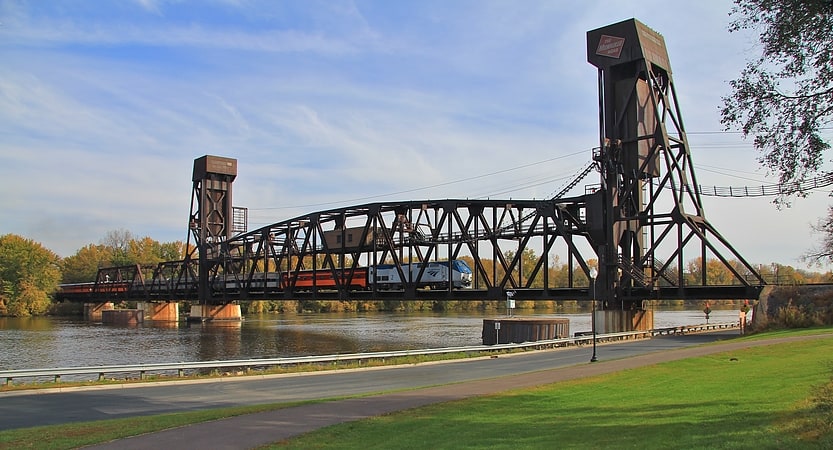
Vertical-lift bridge in Washington County. Hastings Rail Bridge is a vertical-lift bridge that spans the Mississippi River in Hastings, Minnesota. It is one of only four lift spans on the Mississippi River, the others being at Hannibal, Missouri, Burlington, Iowa and in downtown St. Paul, Minnesota. It was built in 1981 by Milwaukee Road and was designed by Howard, Needles, Tammen & Bergendoff.
It crosses the Mississippi river in a north–south orientation from Hastings just upstream of Point Douglas, where the Saint Croix River empties into the Mississippi river. In addition to CP Rail traffic, the bridge also carries Amtrak's Empire Builder across the river.
Another nearby lift bridge is the Prescott BNSF lift bridge, in Prescott, Wisconsin that crosses the St. Croix River. The two tracks converge at the St. Croix interlocking tower.[2]
LeDuc Historic Estate
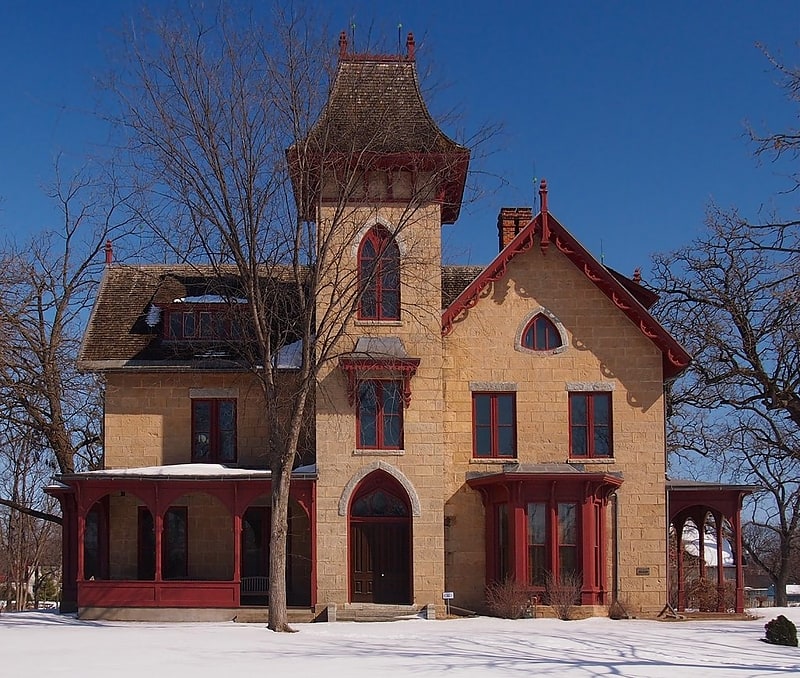
Historical landmark in Hastings, Minnesota. The William G. LeDuc House, also known as the LeDuc Historic Estate, located at 1629 Vermillion Street in Hastings, Minnesota, United States, is listed on the National Register of Historic Places. It was built over several years, and completed in 1865, by William Gates LeDuc who came to Minnesota in 1850 from Ohio. He was an attorney who represented a party to a suit involving Vermillion Falls, 1,500 feet southeast of the homesite. As payment for his services, Le Duc received the land where he built his house. LeDuc was a Civil War veteran and U.S. Commissioner of Agriculture under President Hayes.
The estate is an unusually complete example of the Carpenter Gothic style of Andrew Jackson Downing, a pioneer in American landscape architecture. William, and his wife Mary, used Downing's book, Cottage Residences, as inspiration for their home (Downing himself had died in 1852). The home was the first property to be acquired by the Minnesota Historical Society in the late 1950s but sat empty until 2005, when it was acquired by the City of Hastings. The Dakota County Historical Society partnered with the city to provide programing and interpretative services. $1.2 million was raised to restore the home and grounds to their former glory.
Construction on the LeDuc house began in 1862 and was completed in 1866. Following LeDuc's service as Quartermaster in the Civil War, the family moved into the unfinished home in August, 1865. In March, 1865 he had been brevetted a brigadier general for "efficiency, intelligence and zeal in the discharge of his duties".
William G. LeDuc came to St. Paul, Minnesota Territory in 1850 from Ohio to open a book store and law office. In 1854 he purchased a quarter share in the town of Hastings from Alexander Faribault. In 1856, he and his wife Mary Bronson LeDuc, with their two daughters moved downriver to Hastings, where they had also acquired two wheat farms and 160 acres with a small grist mill on the falls of the Vermillion River. It was on this property that William and Mary decided to build their dream home.
They chose a Gothic Revival home featured in a later edition of Andrew Jackson Downing's Cottage Residences. Downing was a landscape architect and author, whose reputation as a horticulturist was widespread. He inspired Americans to surround their homes with the beauty of nature and encouraged the use of good design even in planning farmsteads. William and Mary chose three Downing designs for their rural home site; their residence, Carriage Barn and Ice House. The estate is an unusually complete example of the Gothic Revival style of Andrew Jackson Downing.
Carroll Simmons, a friend of the LeDuc grandchildren, purchased the home in 1940 for his antique business. In 1958 he donated the home and outbuildings with 4 acres of land to the Minnesota Historical Society, with the agreement that he would continue using it for his antique business until he retired, which wasn't until 1986. Between 1986 and 2003 the future of the property was uncertain. Although it was the first property acquired by MHS, they had opened other house museums by the time they took possession. Needed repairs were done on the house and carriage barn, but the property stood empty.
Citizen groups actively sought out ways to fulfill Carroll Simmons' vision of having the LeDuc house open to the public. In 2002 the Minnesota Legislature apportioned 1.2 million dollars in bonding funds for MHS to preserve the house and bring it up to current building codes. Agreements were executed between the Minnesota Historical Society, the City of Hastings and the Dakota Country Historical Society, which resulted in city ownership and DCHS management of the site.
The site opened for tours on May 22, 2005. June 24, 2005, the Society deaccessioned the LeDuc House to the City of Hastings. As part of the agreement, the Society transferred $604,000 of net assets provided by Carroll Simmons for endowment, repairs and maintenance of the LeDuc House.[3]
Address: 1629 Vermillion St, 55033-3139 Hastings
Ramsey Mill and Old Mill Park

The Ramsey Mill was built by Alexander Ramsey and Dr. Thomas Foster in 1856–1857 on the Vermillion River in the town of Hastings in the U.S. state of Minnesota. The river had a head of 19 feet and a width of 50 feet near the 4 story gristmill. An addition included a cooper shop and storage facility. Although Ramsey sold his interest in 1877, it retained his name. Maximum output was achieved in 1894, at 125 barrels per day. On December 22, 1894, the building burned, possibly due to arson.[4]
Norrish House
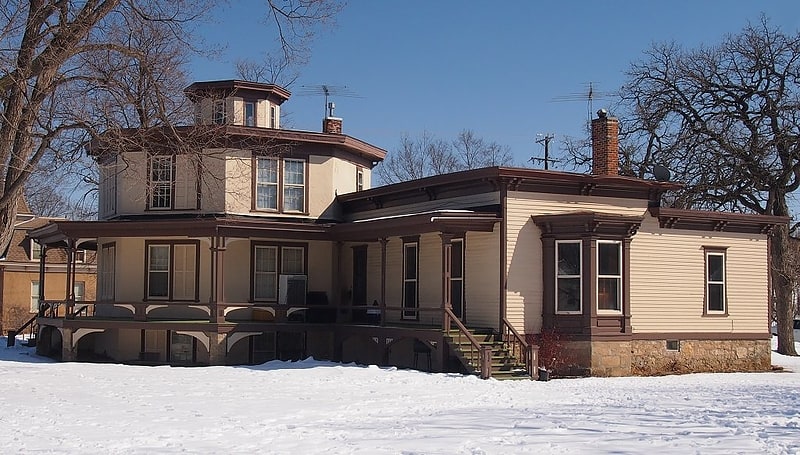
The Claflin-Norrish House is a historic octagonal house located in Hastings, Minnesota, United States; a contributing property to the West Second Street Residential Historic District. The two-story home was built of limestone covered with stucco. Special features include a windowed cupola and wrap-around porch. It still stands at Spring and West 2nd Streets. It is one of scores of eight-sided homes built in the antebellum United States.[5]
First Presbyterian Church
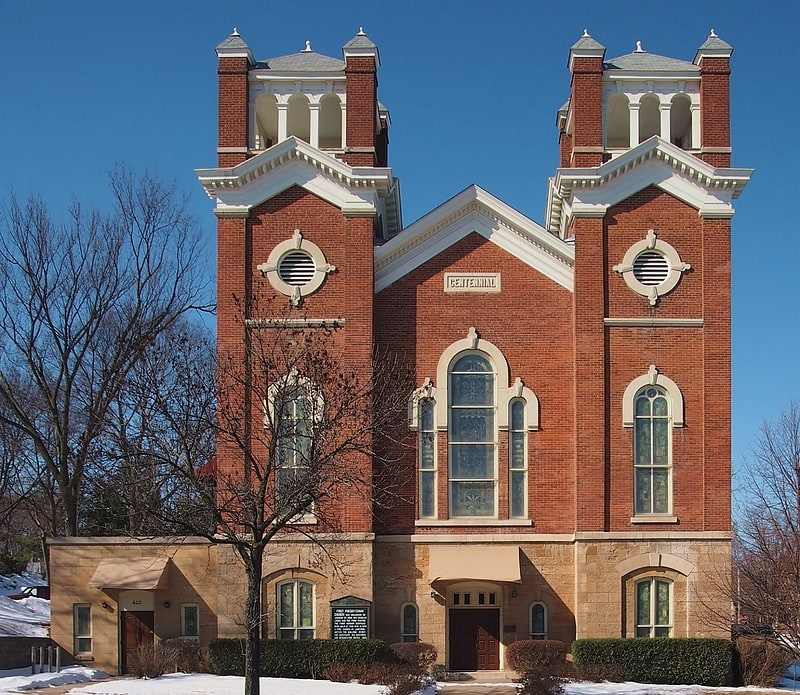
Presbyterian church in Hastings, Minnesota. First Presbyterian Church, known also as First United Presbyterian Church, is a church located at 602 Vermillion Street in downtown Hastings, Minnesota, United States, listed on the National Register of Historic Places. It is significant for its Romanesque architecture. The building is characterized by its massive quality, its thick walls, round arches, large towers, and decorative arcading.
The congregation was established in 1855 by Reverend Charles LeDuc, the brother of William LeDuc. The congregation built a stone church at that time, then decided to build a new, larger church in 1875. It was designed by Charles N. Daniels. Because of financial difficulties, it took nearly seven years to finish the building, although it was complete enough to host its first services in 1881.
In 1907 the tall steeple was struck by lightning, which started a fire that left the church gutted. Architect Harry Wild Jones from Minneapolis was hired to design the restoration. He was asked to make the new church resemble the original as much as possible, so both the interior and the exterior are his work.[6]
Address: 602 Vermillion Rd, 55033 Hastings
Hastings Foundry-Star Iron Works
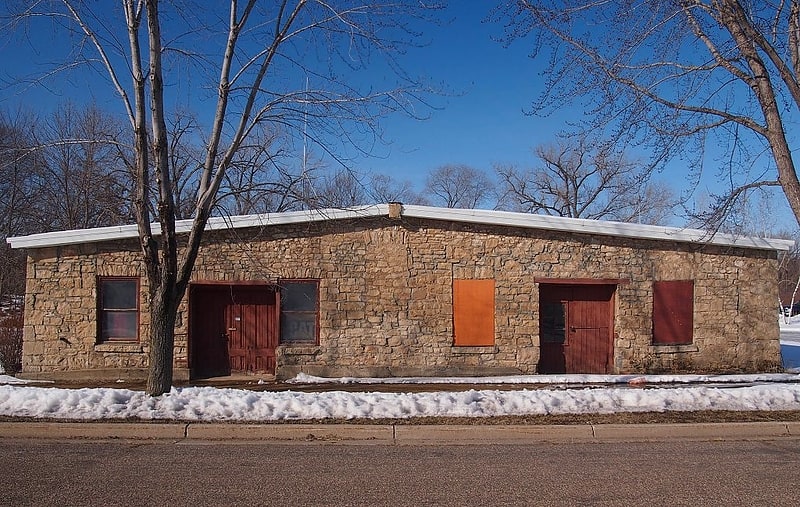
Building in Hastings, Minnesota. The Hastings Foundry-Star Iron Works is a historic foundry building in Hastings, Minnesota, United States. Located at 707 First Street East, it was built by A. R. Morrell, an ironsmith from Vermont, in 1859. The building is historically significant as the location where the first steam engine in Minnesota was built. In 1861 the engine for the Stella Whipple was manufactured there as well. Iron for bridges and engines for railroad elevators, automobiles, and river boats were manufactured in this earliest surviving industrial site in the state.[7]
Hastings Methodist Episcopal Church
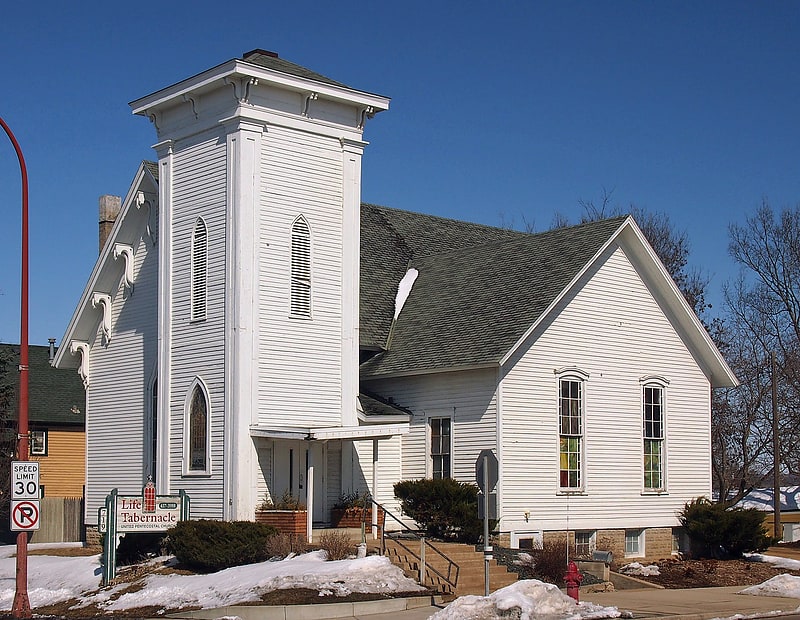
Church building in Hastings, Minnesota. Hastings Methodist Episcopal Church is a church building located at 719 Vermillion Street in downtown Hastings, Minnesota, United States, listed on the National Register of Historic Places. It is significant for its Gothic Revival, Greek Revival, and Italianate architecture. The building exterior is clapboard with a characteristic tower including abat-sons and emphatic eaves supported by corbels. It is the oldest church building in Hastings, originally built in 1862 on 5th Street, it was moved to its present location in 1871; at that time the tower was added. The building is currently used by the Life Tabernacle Pentecostal Church.[8]
Lock and Dam No. 2

Lock and Dam No. 2 is located along the Upper Mississippi River near Hastings, Minnesota and construction commenced in 1927. The eastern dam portion is 722 feet wide and has 19 tainter gates. A hydroelectric station that produces about 4.4 megawatts is owned by the city of Hastings, while the 110 by 600 feet lock is operated by the St. Paul district of the U.S. Army Corps of Engineers' Mississippi Valley Division. There's also a wide earthen dam on the western side of the facility.
Following construction, the original lock walls settled and began to lean out of alignment, so a replacement lock was built. It was finished in 1948. A rehabilitation phase ran from 1987 to 1995. In 2009, Lock and Dam No. 2 became home to the nation's first commercial, federally licensed hydrokinetic power facility, which is a partnership between the City of Hastings and Hydro Green Energy, LLC of Westmont, IL.[9]
Byron Howes House
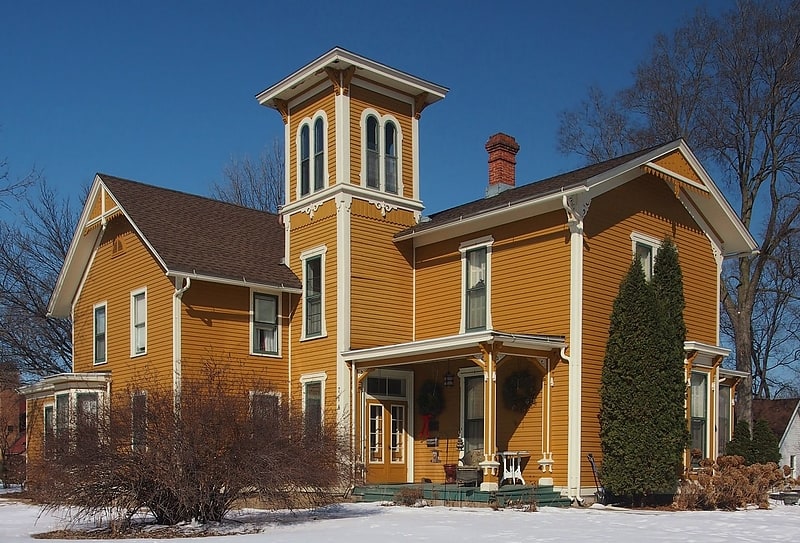
The Byron Howes House is a historic house located at 718 Vermillion Street in Hastings, Minnesota.[10]
Thompson-Fasbender House
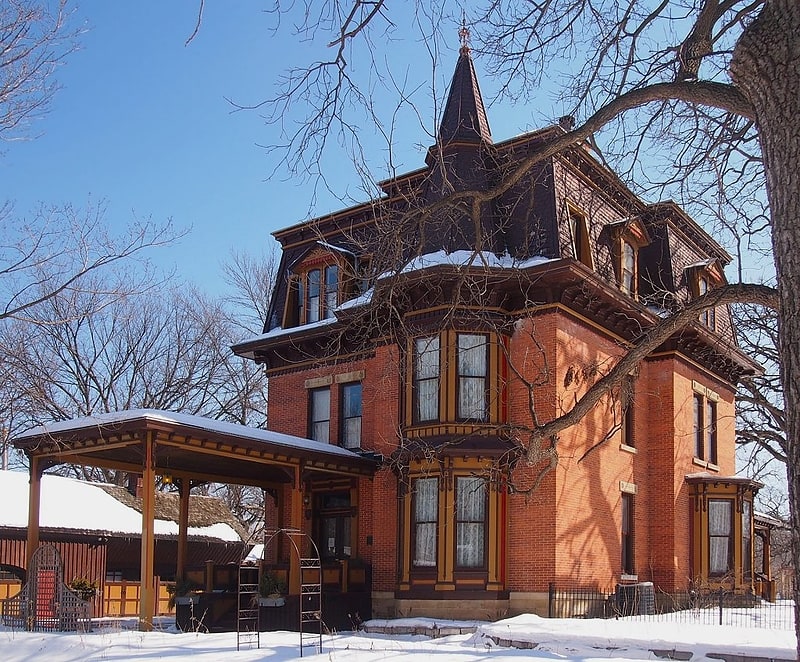
Building in Hastings, Minnesota. The Thompson–Fasbender House, located at 649 West 4th Street in Hastings, Minnesota is listed on the National Register of Historic Places. It was built in 1880 by William Thompson who came to Minnesota in 1857 from Maine. He was a banker, wheat-buyer, and land-owner who also was part-owner of a saw mill and door and sash factory. His access to woodworkers is reflected in the home's finishing. Its Second Empire architecture is reflected in its mansard roof featuring scalloped wooden shingles and bracketed cornices.
In 1929, Dr. Herman Fasbender, Sr. purchased the home and transformed it into Saint Raphael Hospital, which had been housed in the VanDyke-Libby House. When the Regina Memorial Hospital opened in 1953, Saint Raphael closed and the house was converted into a tenement building; Fasbender then moved his practice to the Fasbender Clinic building. Today the home is a bed and breakfast inn.[11]